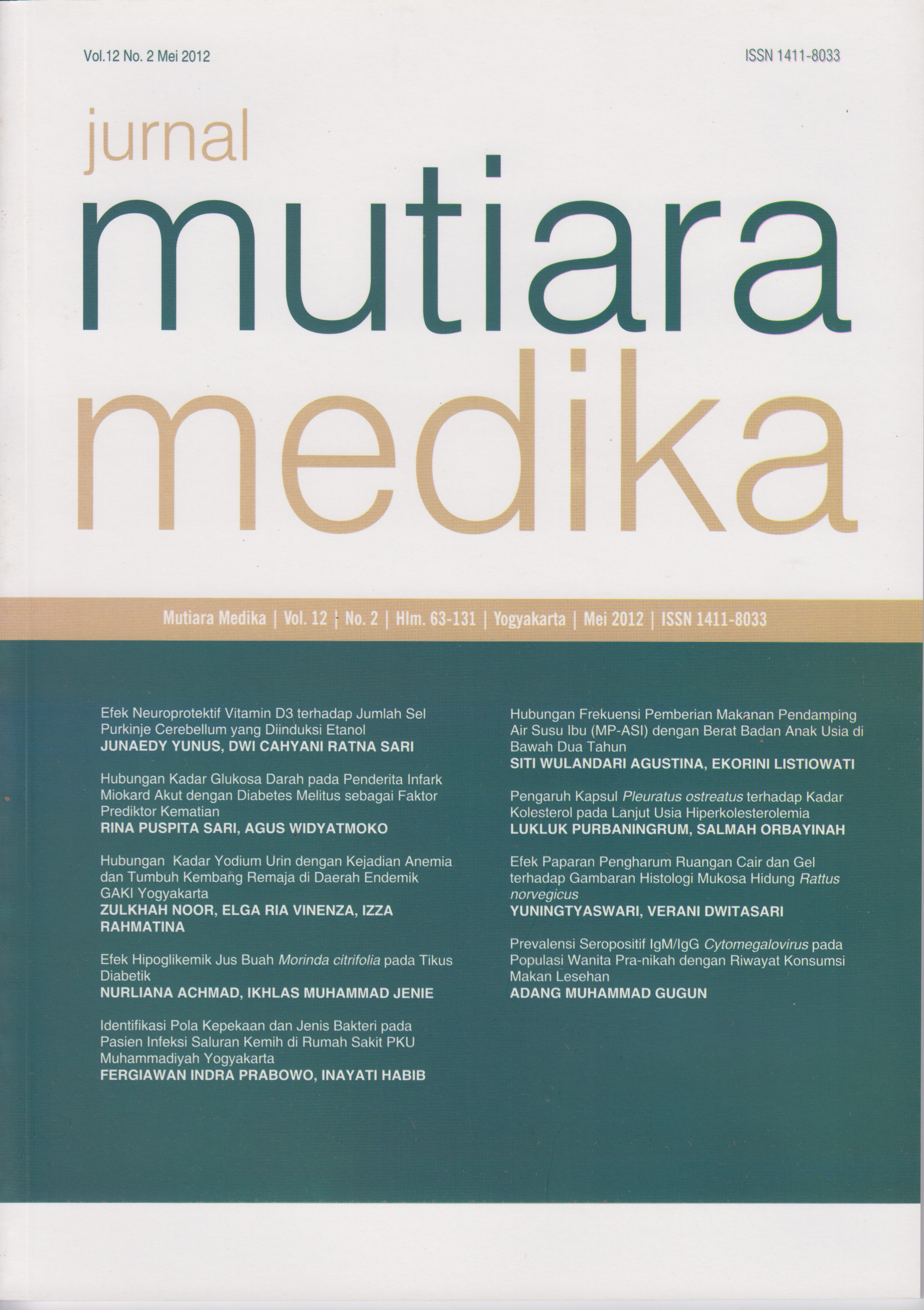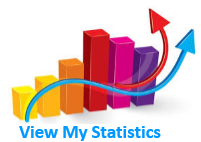Hubungan Kadar Yodium Urin dengan Kejadian Anemia dan Tumbuh Kembang Remaja di Daerah Endemik GAKI Yogyakarta
DOI:
https://doi.org/10.18196/mmjkk.v12i2.1004Keywords:
ekskresi iodium urin (EIU), IMT, spermarche, anemia, urine iodine excretion (UIE), BMI,Abstract
Gangguan pertumbuhan fisik dan seksual serta Anemia pernisiosa masih sering dijumpai pada pasien hipotiroidisme subklinis. Tujuan dari penelitian ini adalah untuk mempelajari hubungan kadar ekskresi iodium urin (EIU) dengan anemia dan tumbuh kembang remaja termasuk indeks massa tubuh, usia menarche dan spermarche remaja di daerah endemik GAKI di Yogyakarta. Penelitian ini merupakan penelitian observasional, dengan desain secara cross sectional. Responden penelitian sebanyak 59 anak usia 12-16 tahun, terdiri dari 30 anak dari Lemahdadi, Bangunjiwo, Kasihan, Bantul dan 29 anak dari Karangwuluh, Temon Kulon Progo. Kadar EIU diukur dengan metode dry digestion di BP GAKI Magelang, pengukuran darah dilakukan di Hi-Lab di Yogyakarta. Pertumbuhan dan perkembangan remaja diperoleh melalui kuesioner, timbangan dan stadiometer. Data dianalisis dengan uji Mann Whitney dan uji korelasi Spearman. Kadar EIU responden termasuk kategori berlebihan dan sangat berlebihan. Persentase tertinggi BMI normal (56,25%) diperoleh pada kelompok EIU optimal. Sebaliknya, persentase IMT kurang tertinggi terdapat pada kelompok EIU berlebih (76,47%) dan sangat berlebih (58,82%). Usia menarche dan spermarche responden adalah normal. Presentase anemia ditemukan sebanyak 33,90%. Disimpulkan bahwa tidak terdapat hubungan antara tingkat EIU dengan BMI, usia menarche dan spermarche dan jenis anemia (p > 0,05).
Impaired physical growth, sexual and Pernicious anemia is frequently found in patients with subclinical hypothyroidism. The purpose of this study is to investigate the relationship with the UIE levels of anemia, and growth and development of adolescents, including body mass index, menarche and spermarche of adolescent in two GAKY endemic areas in Yogyakarta. This study is an observational, cross sectional design. Respondents are 59 children aged 12-16 years, consisted of 30 children from Lemahdadi, Bangun Jiwo, Kasihan, Bantul. and 29 children from Karangwuluh, Temon, Kulon Progo. Urinary iodine levels was measured by digestion method in BP GAKY Magelang, blood measurement carried out in Hi-Lab in Yogyakarta. Adolescent growth and development obtained through a questionnaire, the scales and stadiometer. Data were analyzed with Mann Whitney test and Spearman correlation test. The level of UIE of respondents in the two areas of research were excessive and very excessive. Highest percentage of normal BMI (56.25%) obtained at optimal UIE group. In contrast, the highest percentage of less BMI present in excess UIE group (76.47%) and very excess (58.82%). Spermarche and menarche age of respondents were normal. Percentage of anemia was found as 33.90%. It can concluded that there was no relationship between the level of UIE with BMI, age of menarche and spermarche and type of anemia (p> 0.05).
References
Bakta IM. Buku Ajar Ilmu Penyakit Dalam. Jakarta: Fakultas Kedokteran Indonesia. 2006. 2. Roychowdhury, J., Chaudhuri, S., Sakar, A. Biswas, PK. A Study to Evaluate The Aethiological Factors And Management Of Puberty Menorrhagia. Online J Health Allied Scs. 2008; 7 (1): 5.
Larsen, P. R., Davies, T. F., Hay, I. D. dan Schlumberger, M. J. Thyroid Physiology and Diagnostic Evaluation of Patients With Thyroid Disorders. H. M. Krenenberg, K. S. Polonsky, P. R. Larsen, S. Melmed (Eds.), Williams Textbook of Endocrinology (pp.1656, 1661-1663). USA: Saunders. 2002.
Dabbaghmanesh, MH., Sadegholvaad, A., Ejtehadi, F., Omrani, GR. The Role of Iron Deficiency in Persistent Goiter. Arch Iran Med. 2008; 11 (2): 157-61.
Widodo. Hasil Analisis Pemeriksaan IEU Kabupaten Kulon Progo. Balai Penelitian GAKY Jayan Borobudur Magelang. 2003.
Pardede, LVH., Harjowasito, W., Gross, R., Dillon DH, Totoprajogo OS, Yosoprawoto M, et al. Urinary Iodine Excresion Is the most Appopriate Outcome Indicator for Iodine Defisiensi et Field Conditions at District Level. J Nutr. 1998; 128 (7):1122–6.
Pennington cit Zimermann MB., Ito, Y., Hess, SY., Fujieda, K., Molinari, L.. 2005, Hight Thyroid Volume in Children with Excess Dietery Iodine Intakes. Am J Clin Nutr. 2005; 81 (4): 840-4.
Budiman. BSI, Hubungan antara Konsumsi Iodium dan Gondok pada Siswi Berusia 15-17 Tahun. Bogor: Universa Medisina. 2007.
Noor, Z, Pranacitra, S., Hasanin, AR., Dianty,I. Hubungan Kadar Iodium Urin terhadap Tumbuh Kembang Remaja di Daerah Endemik Gondok. Laporan Penelitian. LP3M UMY. 2009.
Seal, AJ., Creeke, PI., Gnal, D., Abdalla, F., Mirghani, Z., Excess Dietary Iodine in Longterm African refugees. Public Health Nutr. 2006 ; 9 (1): 35-39.
Widodo US. Hasil Analisis Pemeriksaan EYU Kabupaten Kulon Progo. Magelang: BP GAKY Departemen Kesehatan Republik Indonesia. 2007.
Soetjiningsih. Buku Ajar Tumbuh Kembang Remaja dan Permasalahannya. Jakarta: Sagung Seto, 2004.
Guyton, A.C. dan Hall, J. E. Hormon Metabolik Tiroid, Buku Ajar: Fisiologi Kedokteran 9th ed (hal. 1187 – 1199). Jakarta: EGC. 2007.
Doufas, AG., Mastorakos, G., 2006. The Hypothalamic-Pituitary-Thyroid Axis And The Female Reproductive System. Ann N Y Acad Sci. 2000; 900: 65-76.
Mesa Ruben, M. 2009. What Causes Low Hemoglobin Count. Diakses pada Januari 2010 dari http://www.mayoclinic.com/health/low-hemoglobin/AN01295.
Enardi, OP. 2011. Hubungan Status Gondok dengan Pola Menstruasi dan Kejadian Anemia pada Wanita Usia Subur Daerah Endemik Gaki di Kenagarian Siguntur Kecamatan Sitiung Kabupaten Dharmasraya Sumatera Barat. Electronic Thesis and Desertation, Gadjah Mada University.
Downloads
Published
Issue
Section
License
Copyright
Authors retain copyright and grant Mutiara Medika: Jurnal Kedokteran dan Kesehatan (MMJKK) the right of first publication with the work simultaneously licensed under an Attribution 4.0 International (CC BY 4.0) that allows others to remix, adapt and build upon the work with an acknowledgment of the work's authorship and of the initial publication in Mutiara Medika: Jurnal Kedokteran dan Kesehatan (MMJKK).
Authors are permitted to copy and redistribute the journal's published version of the work (e.g., post it to an institutional repository or publish it in a book), with an acknowledgment of its initial publication in Mutiara Medika: Jurnal Kedokteran dan Kesehatan (MMJKK).
License
Articles published in the Mutiara Medika: Jurnal Kedokteran dan Kesehatan (MMJKK) are licensed under an Attribution 4.0 International (CC BY 4.0) license. You are free to:
- Share — copy and redistribute the material in any medium or format.
- Adapt — remix, transform, and build upon the material for any purpose, even commercially.
This license is acceptable for Free Cultural Works. The licensor cannot revoke these freedoms as long as you follow the license terms. Under the following terms:
Attribution — You must give appropriate credit, provide a link to the license, and indicate if changes were made. You may do so in any reasonable manner, but not in any way that suggests the licensor endorses you or your use.
- No additional restrictions — You may not apply legal terms or technological measures that legally restrict others from doing anything the license permits.






